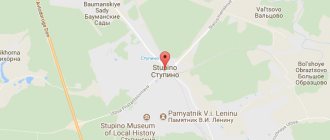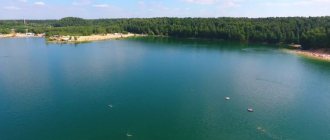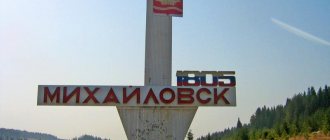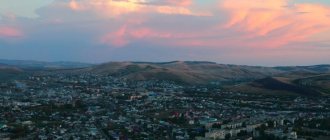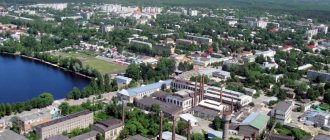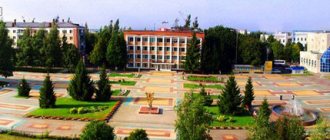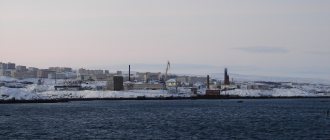| City | |
| Losino-Petrovsky | |
| Flag | Coat of arms |
Moscow
Losino-Petrovsky
Losino-Petrovsky
Losino-Petrovsky
Media files on Wikimedia CommonsLosino-Petrovsky
(until 1928 -
Petrovskaya Podgorodnaya Sloboda
) - a city of regional subordination in the Moscow region of Russia.
Located 24 km northeast of Moscow, on the right bank of the Klyazma River, at the confluence of the Vorya River, 3 km from the Monino railway station. The population of the city is 25,404[1] people. (2020). Together with 17 settlements it forms the Losino-Petrovsky urban district
.
Story
In 1708, on the site of the modern city, by order of the Ingermanland Palace Chancellery, the state-owned Elk tannery was founded to produce ammunition for the Russian Army. At the manufactory, 15 houses were built for shop workers and their families. In 1709, the Elk State Manufactory produced 4 thousand leathers for the needs of the Russian Army of the new system.
The place was chosen by the Ingermanland Chancellery near the palace village of Nikolskoye-Sobakino on the right bank of the Klyazma River at the confluence of the Vorya River, where the working settlement of the Elk Plant arose on the state lands of the Izmailovo volost. The settlement at the Losiny plant grew and developed and merged with the village of Nikolskoye, which lost its name. The workers' settlement that emerged had an official name - Petrovskaya Podgorodnaya Sloboda.
The city's local history museum contains a document - a report from the newspaper "Moskovskie Vedomosti" No. 24 dated October 21, 1822, entitled "Consecration of the church in Petrovskaya Sloboda on September 14-15, 1822." Also in the magazine No. 1 “Bogorodsky Krai” there is a Directory of descriptions of plants and factories in the Bogorodsky district of the Moscow province, compiled by A.P. Shramchenko for 1890. On page 11 there is an entry:
- “Elk factory, Society of the petty bourgeois of the Petrovskaya Subgorod Sloboda.”
The Losiny plant and the Petrovskaya suburban settlement of the Bogorodsky district gave the name Losino-Petrovsky, first to a working village, and then to the city.
In the middle of the 19th century, several large textile factories, founded by Vasily Sergeevich Shishov and Alexander Petrovich Belov, appeared around the Petrovskaya suburban settlement and the center of the textile industry was formed.
After the October Revolution (1917), the factories of Shishov and Belov were nationalized and merged into one powerful textile production, the city-forming Moninsky Order of Lenin worsted mill. On which up to 9 thousand residents of Losino-Petrovsky worked.
In 1920, a census of the Petrovskaya suburban settlement was carried out in which 1276 people lived. There were 135 properties, 365 residential apartments, of which 8 were empty. In 1921, the Executive Committee of Soviet Power was officially called the Losino-Petrovsky Council. Chairman of the Losino-Petrovsky Executive Committee Volkov I.I., secretary Mednikov.
In 1928, Petrovskaya Subgorodnaya Sloboda, as a result of the reform of administrative-territorial entities, was transformed into a workers' settlement, which received the official name Losino-Petrovsky
.
By Decree of the Presidium of the Supreme Soviet of the RSFSR dated July 12, 1951 No. 751/9, on the Day of the Holy Apostles Peter and Paul, the working village of Losino-Petrovsky received the status of a city of regional subordination. [2]. July 12, 1951 is the legal date of formation of the city of Losino-Petrovsky.
On July 11, 1996, the city of Losino-Petrovsky received the status of a city of regional subordination and was removed from the Shchelkovsky district [3]. On February 1, 2001, by the Law of the Moscow Region of January 17, 2001, Losino-Petrovsky lost the status of a city of regional subordination and was returned to the Shchelkovsky district [4].
In 2002, the village of Sitkovo was included in the city[5].
In 2004, the city formed the urban district of Losino-Petrovsky[6], which consisted of one settlement, which was not part of the Shchelkovsky municipal district.
In 2009, Losino-Petrovsky again received the status of a city of regional subordination[7].
In 2022, all settlements of the abolished urban settlement of Sverdlovsky and the rural settlement of Aniskinskoye, Shchelkovsky municipal district, which were included in the Losino-Petrovsky urban district, were reassigned to the city [8].
Church of the Nativity of the Virgin Mary (Aniskino)[edit]
Church of the Nativity of the Mother of God
built in 1738 at the expense of Colonel A.G. Pleshcheev instead of a wooden church of the 18th century. The temple, a stone structure, built in the Moscow Baroque style, is an architectural monument.
During the Soviet years it was closed and suffered greatly. In 1990, the ruins of the building were handed over to believers. Extensive restoration and restoration work was carried out. Currently, the Church of the Nativity of the Blessed Virgin Mary has been completely restored. In 1998 - consecrated.
The church contains icons brought from Jerusalem and from Holy Mount Athos, as well as particles of relics and shrines of the saints of God.
The parish pays great attention to the education of children; the Orthodox gymnasium “Kovcheg” operates at the temple.
Address:
Moscow region, Shchelkovsky district, village. Aniskino, st. Central, 21.
Telephone:
+7 (495) 993 02 61
Population
| Population | ||||||
| 1926[9] | 1931[9] | 1939[10] | 1959[11] | 1967[9] | 1970[12] | 1979[13] |
| 2600 | ↗3600 | ↗8454 | ↗16 688 | ↗20 000 | ↗21 978 | ↘21 964 |
| 1989[14] | 1992[9] | 1996[9] | 1998[9] | 2001[9] | 2002[15] | 2003[9] |
| ↗22 906 | ↘22 500 | ↘21 400 | ↘21 200 | ↘20 800 | ↗22 324 | ↘22 300 |
| 2005[9] | 2006[9] | 2007[9] | 2009[16] | 2010[17] | 2011[9] | 2012[18] |
| →22 300 | ↘22 200 | →22 200 | ↗22 315 | ↗22 550 | ↗22 600 | ↗23 182 |
| 2013[19] | 2014[20] | 2015[21] | 2016[22] | 2017[23] | 2018[24] | 2019[25] |
| ↗23 694 | ↗24 290 | ↗24 726 | ↗25 266 | ↗25 370 | ↗25 424 | ↘25 317 |
| 2020[1] | ||||||
| ↗25 404 | ||||||
As of January 1, 2022, in terms of population, the city was in 567th place out of 1,116[26]cities of the Russian Federation[27].
Alexander Nevsky Church (Monino)[edit]
Alexander Nevsky Church
built in 2007 on the initiative of the Orthodox community of the village, based on the decision of the Commander-in-Chief of the Air Force. The temple is located on the residential territory of the Moninsky garrison.
The area of the main church building with the altar is 120 sq.m. In 2011, the parishioners built extensions to the temple: a refectory with an area of 40 square meters. m and Sunday school - 40 sq.m.
The parish carries out extensive educational work with children and youth. Actively involved in social activities.
The Sunday school “Blooming Vertograd” operates at the temple. Trips to museums and pilgrimages to holy places are made. There is a children's and youth propaganda team.
Address:
Moscow region, Shchelkovsky district, Monino village, st. Krasovskogo, 1.
Local government
Main article: Losino-Petrovsky (urban district)
During the implementation of the Federal Law “On the General Principles of the Organization of Local Self-Government in the Russian Federation” (No. 131-FZ of October 6, 2003), municipalities were created in the Moscow region. Included in the municipal formation is the Losino-Petrovsky urban district
1 settlement was included - the city of Losino-Petrovsky.
By the law of May 23, 2022, the urban settlement of Sverdlovsky and the rural settlement of Aniskinskoye of the Shchelkovsky municipal district are abolished from June 5, 2022 and are included in the Losino-Petrovsky urban district.[28]
Authorities
The local government bodies of the city (urban district) are[29]:
- The Council of Deputies of the City District
is an elected representative body of local self-government. It consists of 25 deputies elected for a term of 4 years[30]. - The head of the urban district
, who is elected by the Council of Deputies of the Losino-Petrovsky urban district for a period of 5 years[31]. - The administration of the city district
is the executive and administrative body of local self-government[32]. The head of the administration is the head of the city district[32]. - The election commission of the city district
is a commission that organizes the preparation and conduct of municipal elections and referendums[33]. It is formed by the Council of Deputies and consists of 8 people[33].
Since 1996, the following have been elected heads of the Losino-Petrovsky urban district: - Kulikova Lyudmila Nikolaevna, Erastov Yuri Vladimirovich, Lipatenkov Vyacheslav Borisovich, Vikharev Andrey Gennadievich, Fetyukov Oleg Valerievich. Since 2022, the head of the city district is Ivan Yuryevich Kurdanin.
Magdalene Church (Ulitkino)[edit]
Magdalene Temple
built in 1748 at the estate of Princess M.D. Cantemir, daughter of the Moldavian ruler Dmitry Cantemir, invited to Russian service by Peter the Great.
In 1835, through the efforts of priest Andrei Sokolov, the temple was expanded and decorated.
During Soviet times, the temple was closed and partially destroyed. All that remains of its former beauty is the 18th-century quadrangle, which has lost its light drum and apse.
Restoration began in 1997. Soon the main shrine, the icon of St. Mary Magdalene, which had been in the neighboring church in the village of Grebnevo, was moved.
Address:
Moscow region, Shchelkovsky district, Ulitkino village, st. Central, 24-a.
Telephone:
+7 (496) 567 38 00
Transport
There are buses and minibuses operating in the city. 362 art. Monino-Losino-Petrovsky (Deli) - Moscow (metro Shchelkovskaya) bus 506 Losino-Petrovsky (Deli) - Moscow (metro Shchelkovskaya) minibus 886 Losino-Petrovsky (Market) - Moscow (metro Perovo) minibus
26 Shchelkovo (Zarechny microdistrict) - st. Monino 30 Losino-Petrovsky (Factory No. 2) - Monino The average travel time by bus or minibus to Moscow (metro station Shchelkovskaya) is 40 minutes. The Monino railway station of the Yaroslavl direction of the Moscow Railway is located 3 kilometers from the city. The travel time of electric trains from the Yaroslavsky station is about 1 hour for express trains and 1 hour 15 minutes for the next ones with all stops, from the Fryazevo station - about 25 minutes.
A little about the owner’s personal life
Lots of Margaritas
Yakov Vilimovich was married, and married happily. All his life he and his wife loved and cared for each other. Yakov Vilimovich's wife's name was Margarita von Manteuffel. She was the daughter of a general, a native of the Baltic states.
They also named their first daughter Margarita, but she lived only a couple of months. In general, the Bryusov family was lucky with Margarita women. There were several of them in the Bruce family. There is such an interesting story about one of them.
The mother of King Robert 1 of Scotland (the ancestor of the Scotsman Bruce) was also called Margaret or Marjorie (which is the same thing), Countess of Carrick. She was married, but her husband died during the Crusade. One day a handsome man came to her to tell the countess about the death of her husband.
Having fallen in love with him at first sight, the woman captivated him. That is, without quotes, she literally captured her and held her until he gave up and agreed to marry her. This is how, in general, the lady was decisive.
The second daughter in the family of Jacob Bruce, Natalya, died when she was only one and a half years old (according to some reports, she lived for 6 months). So there were no children in the Bruce family. His wife died just a year after they settled on Glinka's estate. After her, Jacob Bruce lived alone for another 8 years.
Legends, myths and... knowledge
Bruce did not like social society and very rarely attended balls and other events, considering them a waste of time.
Everything that was interesting to him was in his home: books, documents, instruments for experiments and observations of the night luminaries. It was for this passionate passion for science and his extensive knowledge that Jacob Bruce was known among the common people as a mysterious mystic, magician and sorcerer. His name was simply shrouded in rumors! They were all related to magic, and there were a lot of them!
Local peasants told each other in horror:
- how Bruce was seen flying in and out of his office window on a fire-breathing dragon;
- that, bored in the summer heat, it didn’t cost him anything to freeze the water on the pond and go ice skating;
- they talked about the elixir of youth;
- about a gazebo in the garden of a scientist-wizard, in which music began to play only at the wave of the hand of the owner of the house;
- They also talked about a robot girl who was invented by the magician Jacob Bruce.
By the way, not all the rumors were just nonsense. After the death of the inventor, designs and drawings of the first robot were found in his notes. As the scientist bequeathed, all his notes - and they fit in only 35 (!!!) carts - were transferred to the Academy of Sciences of St. Petersburg.
Bryusov family
Since Bruce had no children, after his death Glinka’s estate near Moscow began to belong to his nephew Alexander. Alexander was married three times. And for the first time on Princess Anastasia Dolgorukova.
His second chosen one was Ekaterina, again, Dolgorukova. At one time she was considered the bride of Emperor Peter 2, but the marriage did not take place due to the sudden illness and death of the groom. Alexander's third wife was Natalya Kolycheva. She came from an ancient family of Moscow boyars.
The next owner of the Glinka estate was Alexander's son Yakov. He was the last of the Russian descendants of the Bryus family.
Yakov Alexandrovich was the governor of Moscow, and his wife, Praskovya, was Catherine 2’s maid of honor. And even more than a maid of honor. You could say they were friends. Catherine affectionately called her friend Brusha, Paranya.
From historical documents of those years it follows that Praskovya was not distinguished by strict morals. And the friendship of the two women was abruptly interrupted when Catherine found her in an unambiguous situation alone with one of her favorites. Praskovya was removed from the court, and she traveled abroad for a long time.
In general, it turned out that husband and wife - Yakov Alexandrovich Bruce and his wife Praskovya - often lived separately from each other. But Yakov Alexandrovich loved his wife. After her death, he commissioned the talented Russian architect Ivan Martos to create an original tombstone with an epitaph for his wife, which began with the words: “To my wife and friend.”
Economy
Main specializations: light industry and services. The city has medium and small private enterprises, a silk weaving factory, supermarkets, a bath complex, a medical center, and a savings bank. In the past there was a poultry farm[34].
Currently, the Losino-Petrovsky urban district is being transformed as a result of complex development. On the territory of the city it is planned to build modern multi-storey residential complexes[35] with their own infrastructure and internal amenities designed for the comfortable living of future residents of the complex. The development area will be more than 13.43 hectares. Future new buildings will house retail and service enterprises: pharmacies, cafes, supermarkets, office space.
Plans for the near future
Restoration work
In 2016, the entire territory with the adjacent garden was bought by modern philanthropist Vyacheslav Fomichev. Previously, with his own money in 2010, he created a military-technical museum in the village of Ivanovskoye (not far from the town of Chernogolovka near Moscow), and in 2016 he restored the Morozov estate in Noginsk.
Now it is planned to completely restore the Glinka estate and open a full-fledged museum there, filled with exhibits from the life of Bruce and his family estate. In 2022, this is exactly what was happening on the territory of the former beautiful estate of Bruce: it is being built, restored, renovated.
Active reconstruction of old buildings is underway.
They are digging and building something near the former club building.
And if you walk around the club building and look from the opposite side, you can find a beautifully finished piece of the room surrounded by fittings and construction debris. What's there? Cafe or restaurant?
Bruce House Museum
In one of the restored outbuildings of the estate, which is located near the ponds (Bruce’s former “storeroom”), the Yakov Vilimovich Bruce Museum is now open.
The Bruce Public House Museum was located on the estate before; it operated since 1991 and was closed in 2006. Gradually, all the exhibits were removed from the territory of Glinka’s estate to the Shchukovsky Museum of Local Lore.
In 2022, part of the collection was returned.
The newly renovated premises contain antique furniture, portraits of Bruce and his entourage.
We collect old photographs, manuscripts, and objects that belonged to the owners of the Glinka estate for many decades.
Exhibition in the central house of the estate
In the main house there is now also an exhibition dedicated to the era of Peter the Great, whose friend and ally was rightfully the owner of the Glinka estate, Yakov Bruce. A tall sculpture of the Russian emperor greets guests of the estate.
On two floors of the premises there are exhibits dedicated to the history of the estate, objects of decorative and applied art, and a collection of antique furniture.
There are a huge number of watches on the shelves.
There are elegant candlesticks on the floor. And for some reason even a cannon with a cannonball.
Well, since we are talking about military equipment, then we smoothly move on to the next section of the article.
What do tanks have to do with it?
They plan to open a historical exhibition on the territory of the modern Glinka estate in Monino. The first exhibits are already there. There are only two of them so far: a tank and some other military vehicle.
They are located behind the clubhouse in the open forest air. This part of the exhibition is planned to be dedicated to the Soviet period in the life of the Monino estate-sanatorium.
Attractions
- In the city there are: a monument to Peter I;
- monument to St. Nicholas the Wonderworker;
- memorial to fallen defenders of the Fatherland;
- monument in honor of those killed during the Second World War.
- To the east of the city there is a small Glinka estate, where Field Marshal Y. V. Bruce, one of the associates of Peter I, lived in retirement.
- In Losino-Petrovsky there are three parishes of the Russian Orthodox Church, belonging to the Losino-Petrovsky church deanery district of the Moscow diocese with active churches: [36]Skorbyashchenskaya (1819), Trinity (1822), Nikolskaya (1822).
- Church "Joy of All Who Sorrow"
- Trinity Church
- St. Nicholas Church
Trinity Church (Ryazan)[edit]
Trinity Church
built in 1784 at the expense of the village owner M.V. Isleneva, instead of the old dilapidated wooden church of the 17th century.
In 1906, according to the Blagoveshchensky project, work was carried out to increase the area of the building; by the middle of the century, the temple building was formed in the Baroque style.
In 1922, the temple was closed; over time, it fell into disrepair and was looted. In 1987-1988, restoration began to create the A.A. Museum. Alyabyeva. Divine services have been held since 1995. In the same year, the icon of the Archangel Gabriel, which is recognized as miraculous, was poured with myrrh. There is a holy spring near the temple.
Address:
Moscow region, Shchelkovsky district, village. Ryazan residents.
Notes
- ↑ 1 2 3
Estimation of the permanent population of the Moscow region as of January 1, 2022 and on average for 2022 for municipalities
(unspecified)
. Mosoblaststat. Access date: April 20, 2022. - THE USSR. Administrative-territorial division of the union republics on January 1, 1980 / Comp. V. A. Dudarev, N. A. Evseeva. - M.: Izvestia, 1980. - 702 p. — P. 174.
- Handbook on the administrative-territorial division of the Moscow region 1929-2004. - M.: Kuchkovo pole, 2011. - 896 p. — 1500 copies. — ISBN 978-5-9950-0105-8.
- Law of the Moscow Region of January 17, 2001 No. 12/2001-OZ // “Podmoskovnye Izvestia”, No. 20, 02/01/2001
- Resolution of the Governor of the Moscow Region dated May 18, 2002 No. 110-PG “On the merger of the village of Sitkovo, Oseevsky rural district, Shchelkovsky district, with the city of Losino-Petrovsky, Shchelkovsky district, Moscow region”
- Law of the Moscow Region dated December 29, 2004 No. 200/2004-OZ “On the status and boundaries of the Losino-Petrovsky urban district”
- Law of the Moscow Region of March 27, 2009 No. 26/2009-OZ “On the transformation of the city of Losino-Petrovsky, Shchelkovsky district, Moscow region, and the city of Elektrogorsk, Pavlovo-Posad district, Moscow region, and amendments to the Law of the Moscow region “On the administrative-territorial structure of the Moscow region””
- Law of the Moscow Region of May 23, 2022 No. 69/2018-OZ “On the merger of the urban settlement of Sverdlovsky, the rural settlement of Aniskinskoye of the Shchelkovsky municipal district with the urban district of Losino-Petrovsky and amendments to some laws of the Moscow region on the status and boundaries of municipalities of the Moscow region”
- ↑ 123456789101112
People's encyclopedia "My City". Losino-Petrovsky - All-Union Population Census of 1939. The size of the urban population of the USSR by urban settlements and intra-city areas (unspecified)
. Retrieved November 30, 2013. Archived November 30, 2013. - All-Union Population Census of 1959. The size of the urban population of the RSFSR, its territorial units, urban settlements and urban areas by gender (Russian). Demoscope Weekly. Access date: September 25, 2013. Archived April 28, 2013.
- All-Union Population Census of 1970 The size of the urban population of the RSFSR, its territorial units, urban settlements and urban areas by gender. (Russian). Demoscope Weekly. Access date: September 25, 2013. Archived April 28, 2013.
- All-Union Population Census of 1979 The size of the urban population of the RSFSR, its territorial units, urban settlements and urban areas by gender. (Russian). Demoscope Weekly. Access date: September 25, 2013. Archived April 28, 2013.
- All-Union population census of 1989. Urban population (undefined)
. Archived from the original on August 22, 2011. - All-Russian population census 2002. Volume. 1, table 4. Population of Russia, federal districts, constituent entities of the Russian Federation, districts, urban settlements, rural settlements - regional centers and rural settlements with a population of 3 thousand or more (unspecified)
. Archived from the original on February 3, 2012. - The size of the permanent population of the Russian Federation by cities, urban settlements and regions as of January 1, 2009 (unspecified)
. Retrieved January 2, 2014. Archived January 2, 2014. - Population census 2010. Population of Russia, federal districts, constituent entities of the Russian Federation, city districts, municipal districts, urban and rural settlements (Russian). Federal State Statistics Service. Access date: January 22, 2013. Archived April 28, 2013.
- Population of the Russian Federation by municipalities. Table 35. Estimated resident population as of January 1, 2012 (unspecified)
. Retrieved May 31, 2014. Archived May 31, 2014. - Population of the Russian Federation by municipalities as of January 1, 2013. - M.: Federal State Statistics Service Rosstat, 2013. - 528 p. (Table 33. Population of urban districts, municipal districts, urban and rural settlements, urban settlements, rural settlements) (undefined)
. Retrieved November 16, 2013. Archived November 16, 2013. - Table 33. Population of the Russian Federation by municipalities as of January 1, 2014 (unspecified)
. Access date: August 2, 2014. Archived August 2, 2014. - Population of the Russian Federation by municipalities as of January 1, 2015 (unspecified)
. Access date: August 6, 2015. Archived August 6, 2015. - Population of the Russian Federation by municipalities as of January 1, 2016 (Russian) (October 5, 2018). Retrieved May 15, 2022. Archived May 8, 2022.
- Population of the Russian Federation by municipalities as of January 1, 2022 (Russian) (July 31, 2017). Retrieved July 31, 2022. Archived July 31, 2022.
- Population of the Russian Federation by municipalities as of January 1, 2022 (Russian). Retrieved July 25, 2018. Archived July 26, 2022.
- Population of the Russian Federation by municipalities as of January 1, 2022 (Russian). Retrieved July 31, 2019. Archived May 2, 2022.
- taking into account the cities of Crimea
- https://rosstat.gov.ru/storage/mediabank/bul_Chislen_nasel_MO-01-01-2021.rar Population of the Russian Federation by municipalities as of January 1, 2022 (1.85 Mb, 07/30/2021)
- Law of the Moscow Region No. 69/2018-OZ “On the merger of the urban settlement of Sverdlovsky, the rural settlement of Aniskinskoye of the Shchelkovsky municipal district with the urban district of Losino-Petrovsky and amendments to some laws of the Moscow Region on the status and boundaries of municipalities of the Moscow Region”
- Charter, 2010, Article 25.
- Charter, 2010, Article 26.
- Charter, 2010, Article 30.
- ↑ 12
Charter, 2010, Article 31. - ↑ 12
Charter, 2010, Article 33. - Liquidated as a result of a raider takeover in 2005. https://www.russia-today.ru/2007/no_17/17_topic_5.htm
- The construction of the Bryusov Park residential complex is planned in the east of the Moscow region in the city of Losino-Petrovsky https://www.kvartirazamkad.ru/viewrealty/objectid/zhk-bryusov-park
- Official website of the Moscow Diocese of the Russian Orthodox Church. Monasteries and temples. Losino-Petrovsky district.
Tikhvin Church (Dushonovo)[edit]
Tikhvin Temple
built in 1839 with funds from manufacturer Tikhon Teushin and local residents.
The temple is an example of a provincial empire style; it was consecrated in 1852, and since then services in it have not been interrupted.
From the time of construction to the present day, the interior decoration of the temple has been preserved - the central iconostasis, cast-iron floors, oil paintings of the second half of the 19th century.
There are many icons in the temple from the 17th-19th centuries, among which the especially revered icon of St. Mitrophania of Voronezh.
Address:
Moscow region, Shchelkovsky district, village. Dushonovo, 130.
Telephone:
+7 (496) 563 44 52
